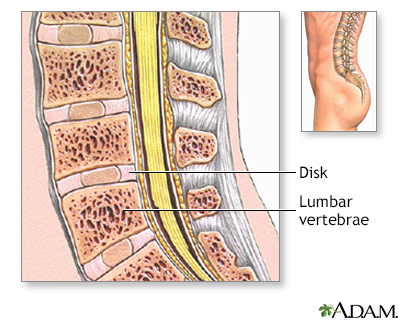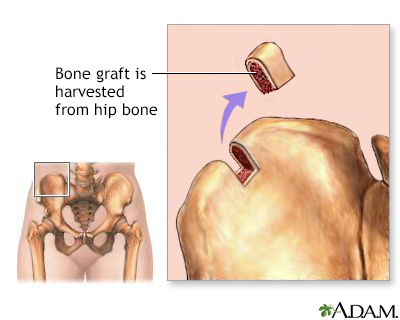Bone graft
Autograft - bone; Allograft - bone; Fracture - bone graft; Surgery - bone graft; Autologous bone graft
A bone graft is surgery to place new bone or bone substitutes into spaces around a broken bone or bone defects to stimulate healing.

The spinal vertebrae are separated by cartilage disks. The cartilage disks are filled with a gelatinous substance, which provide cushioning to the spinal column.

Spinal surgery is sometimes performed to remove a herniated disc. If more than one disc is removed the spine can become unstable, and a procedure to fuse the spine together is needed. The spine can be fused with with bone and plates, rods, or special metal cages. The bone may be taken from the patient's body, usually from the hip.
Description
A bone graft can be taken from the person's own healthy bone (this is called an autograft). Or, it can be taken from frozen, donated bone (allograft). In some cases, a manmade (synthetic) bone substitute is used.
You will be asleep and feel no pain (general anesthesia).
During surgery, the surgeon makes a cut over the bone defect. The bone graft can be taken from areas close to the bone defect or more commonly from the pelvis. The bone graft is shaped and inserted into and around the area. The bone graft may need to be held in place with pins, plates, or screws.
Why the Procedure Is Performed
Bone grafts are used to:
- Fuse joints to prevent movement
- Repair broken bones (fractures) that have bone loss
- Repair injured bone that has not healed
Risks
Risks of anesthesia and surgery in general include:
- Reactions to medicines, breathing problems
- Bleeding, blood clots, infection
Risks of this surgery include:
- Pain at the body area where the bone was removed
- Injury of nerves near the bone grafting area
- Stiffness of the area
Before the Procedure
Tell your surgeon or nurse if:
- You are or could be pregnant
- You are taking any medicines, including medicines, supplements, or herbs you bought without a prescription
During the week before your surgery:
- You may be asked to temporarily stop taking medicines that keep your blood from clotting. These medicines are called blood thinners. This includes over-the-counter medicines and supplements such as aspirin, ibuprofen (Advil, Motrin), naproxen (Aleve, Naprosyn), and vitamin E. Many prescription medicines are also blood thinners.
- Ask your surgeon which medicines you should still take on the day of surgery.
On the day of the surgery:
- Follow instructions about not eating or drinking anything before surgery.
- Take the medicines your provider told you to take with a small sip of water.
- If you are going to the hospital from home, be sure to arrive at the scheduled time.
After the Procedure
Recovery time depends on the injury or defect being treated and the size of the bone graft. Your recovery may take 2 weeks to 3 months. The bone graft itself will take up to 3 months or longer to heal.
You may be told to avoid extreme exercise for up to 6 months. Ask your surgeon or nurse what you can and cannot safely do.
You will need to keep the bone graft area clean and dry. Follow instructions about showering.
Do not smoke. Smoking slows or prevents bone healing. If you smoke, the graft is more likely to fail. Be aware that nicotine patches slow healing just like smoking does. You may also be told not to take non steroidal anti-inflammatory drugs (NSAIDs) such as ibuprofen or naproxen. These medicines can slow down bone fusion.
You may need to use a bone stimulator. These are machines that can be worn over the surgical area to stimulate bone growth. Not all bone graft surgeries require the use of bone stimulators. Your surgeon will let you know if you'll need to use a bone stimulator.
Outlook (Prognosis)
Most bone grafts help the bone defect heal with little risk of graft rejection.
References
Brinker MR, O'Connor DP. Nonunions: evaluation and treatment. In: Browner BD, Jupiter JB, Krettek C, Anderson PA, eds. Skeletal Trauma: Basic Science, Management, and Reconstruction. 6th ed. Philadelphia, PA: Elsevier; 2020:chap 26.
Seitz IA, Teven CM, Hendren-Santiago B, Reid RR. Repair and grafting of bone. In: Gurtner GC, Pusic AL, eds. Plastic Surgery, Volume 1: Principles. 5th ed. Philadelphia, PA: Elsevier; 2024:chap 20.
Version Info
Last reviewed on: 8/27/2024
Reviewed by: C. Benjamin Ma, MD, Professor, Chief, Sports Medicine and Shoulder Service, UCSF Department of Orthopaedic Surgery, San Francisco, CA. Also reviewed by David C. Dugdale, MD, Medical Director, Brenda Conaway, Editorial Director, and the A.D.A.M. Editorial team.
